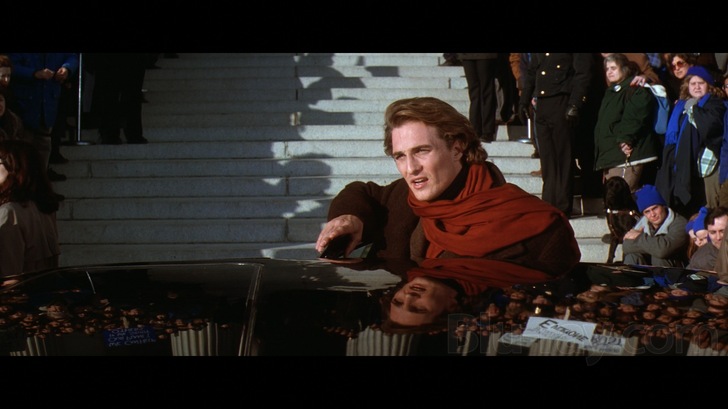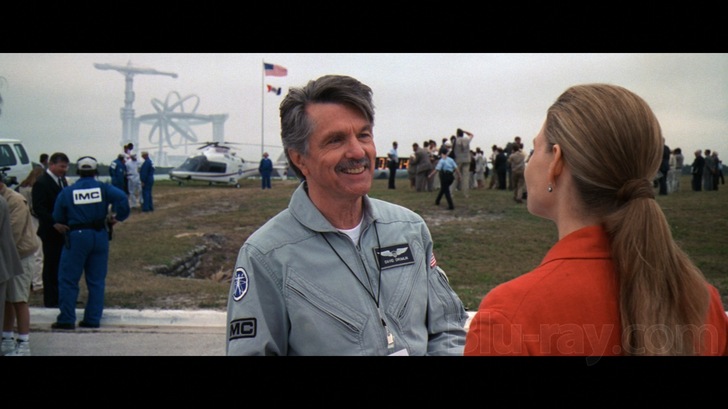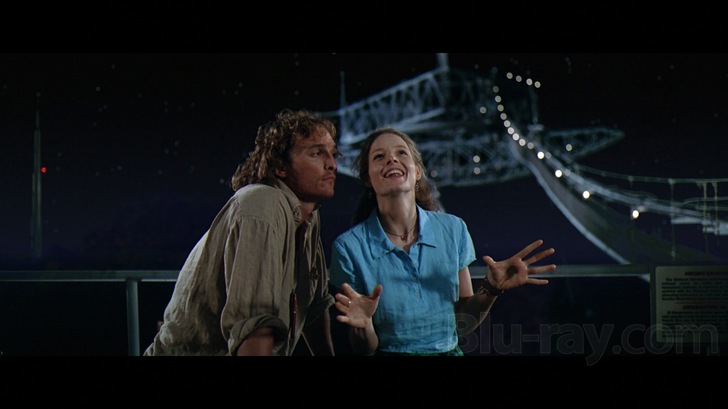Contact Blu-ray Movie
HomeContact Blu-ray Movie 
Warner Bros. | 1997 | 150 min | Rated PG | Oct 06, 2009Movie rating
7.8 | / 10 |
Blu-ray rating
| Users | 4.3 | |
| Reviewer | 4.0 | |
| Overall | 4.2 |
Overview
Contact (1997)
Dr. Ellie Arroway, after years of searching, finds conclusive radio proof of intelligent aliens, who send plans for a mysterious machine. Based on the novel by Carl Sagan.
Starring: Jodie Foster, Matthew McConaughey, James Woods, John Hurt, Tom SkerrittDirector: Robert Zemeckis
| Sci-Fi | Uncertain |
| Mystery | Uncertain |
| Drama | Uncertain |
| Thriller | Uncertain |
Specifications
Video
Video codec: VC-1
Video resolution: 1080p
Aspect ratio: 2.40:1
Original aspect ratio: 2.39:1
Audio
English: Dolby TrueHD 5.1 (48kHz, 16-bit)
Japanese: Dolby Digital 5.1
Spanish: Dolby Digital 5.1 (640 kbps)
French: Dolby Digital 5.1 (640 kbps)
German: Dolby Digital 5.1 (640 kbps)
Italian: Dolby Digital 5.1 (640 kbps)
Portuguese: Dolby Digital 2.0
English: Dolby Digital 5.1 (640 kbps)
Castillian Spanish, Japanese is hidden
Subtitles
English SDH, French, German SDH, Italian, Italian SDH, Japanese, Portuguese, Spanish, Danish, Dutch, Finnish, Norwegian, Swedish
Discs
50GB Blu-ray Disc
Single disc (1 BD)
Playback
Region free
Review
Rating summary
| Movie | 4.0 | |
| Video | 4.0 | |
| Audio | 4.0 | |
| Extras | 3.0 | |
| Overall | 4.0 |
Contact Blu-ray Movie Review
Astronomy is looking up.
Reviewed by Casey Broadwater October 13, 2009To quote sci-fi great Arthur C. Clarke, “Two possibilities exist: Either we are alone in the universe, or we are not. Both are equally terrifying.” And both, most would agree, are equally difficult to physically substantiate. While Clarke was speaking of extraterrestrial intelligence, his quip could just as aptly apply to God, that other unproven heavenly figure. Astronomer, skeptical inquirer, and agnostic Carl Sagan, author of Contact, devoted his life to seeking the uneasily obtained answer to one of humanity’s central questions—are we alone? Of course, his was a strictly scientific quest, one that led him to being an early proponent of SETI—the Search for Extra- Terrestrial Intelligence—but he was also interested in what ramifications the discovery of alien life would have on our world’s insular, anthropocentric faiths. And yet Sagan, unlike hardliners like Richard Dawkins, didn’t want to destroy religion. He just wanted to see it evolve, so to speak.

The truth is out there.
In Pale Blue Dot, Sagan wrote, “How is it that hardly any major religion has looked at science and concluded, ‘This is better than we thought! The Universe is much bigger than our prophets said, grander, more subtle, more elegant’?” Sagan then concludes that a “religion, old or new, that stressed the magnificence of the Universe as revealed by modern science might be able to draw forth reserves of reverence and awe hardly tapped by the conventional faiths.” Fittingly, then, Contact is a film that explores the intersection of science and faith, a film that admits there are no easy answers, and that looks outward in transcendent amazement at the universe that we inhabit. The opening shot literally does just that. We start on a close-up of Earth as seen from space, and hear a cacophony of radio chatter and television signals, all broadcasting out into the void. As we pull back, past the moon, past Jupiter and Saturn and the nearest star systems, the sounds subside into silence and our tiny place in the Milky Way is lost among billions upon billions of galaxies tumbling end over end into nothingness. Yes, we are very small.
The film starts in earnest with Dr. Ellie Arroway (Jodie Foster), a SETI researcher working at the Arecibo Observatory in Puerto Rico. Given the fringe nature of her work, funding is quickly cut by David Drumlin (Tom Skerritt), a soulless scientist-turned-bureaucrat who thinks Ellie is wasting her time looking for little green men. After procuring private resources from eccentric bajillionaire industrialist S.R. Hadden (John Hurt), Ellie continues her search at the Very Large Array in New Mexico, where she discovers a pulsing signal from the Vega system that contains a sequence of prime numbers—indisputable evidence of extraterrestrial intelligence. What’s more, the signal also includes a ciphered message, blueprints for a machine that Ellie theorizes might be some kind of interstellar travel device. The U.S. government—in a display of uncharacteristic efficiency —quickly builds the machine, but it’s destroyed by a religious fanatic. S.R. Hadden then reveals to Ellie that a second machine has been built in Japan (“First rule of government spending: Why build one when you can have two for twice the price?”) and invites her to be the device’s passenger. What follows—and I won’t spoil it for those who haven’t seen the film—is an interstellar voyage, an almost religious experience that Ellie, much to her scientific chagrin, can’t prove actually happened.
Throughout the film, Ellie’s belief in the extraterrestrials—she has faith, without evidence, that the machine serves a benevolent purpose—is compared and contrasted with the religious belief of Palmer Joss (Matthew McConaughey), a theological pop-philosopher with whom Ellie shares a one night stand in Puerto Rico. (He’s “a man of the cloth, without the cloth.”) While lying in bed with Ellie, Palmer describes his religious conversion, a subjective experience that left him absolutely convinced of God’s existence. This is echoed later in Ellie’s journey into the cosmos, a trip she can neither deny nor substantially prove. When Joss is called to comment on the validity of Ellie’s claims, he tidily sums up the film’s message. “As a person of faith,” he says, “I’m bound by a different covenant than Dr. Arroway. But our goal is one and the same: the pursuit of Truth. I, for one, believe her.” The point seems to be that science and religion don’t have to be opposing camps, or non-overlapping magisteria, as atheism-apologist Stephen Jay Gould has described them. Rather, the whole of the human experience can be encompassed if religion lets go of some outmoded myths and if science accepts faith as an adjacent method of discovery. Now, I’m the first to admit that that’s an extraordinarily tall order, but I have to give credit to the film for not being preachy or aggressively one-sided. When it comes down to it, Contact is about having a sense of awe and curiosity about our place in the cosmos, about strict rationalists learning to wonder at the majesty of the universe, and about the religiously devout becoming comfortable enough with their own beliefs to investigate the empirical evidence at hand.
With all this scientific/philosophical talk, the film could’ve easy devolved into a flighty, didactic discourse, but thankfully the proceedings are grounded by solid acting—Jodie Foster’s brilliant performance is impassioned and vulnerable—a relatively tight script, and a sense of realism that’s lacking in most big-budget sci-fi epics. Contact certainly has its share of loose threads—a few gaping plot holes and a handful of eyebrow-raising implausibilities among them—but it requires much less suspension of disbelief than similar films. Part of this is due, naturally, to Carl Sagan’s continued involvement with the project. After he first wrote the screenplay in 1979, the title roasted for some 15 years in development hell, a waiting game that prompted Sagan to go ahead and write a best-selling novelization of the story. When production finally geared up, he was on hand to assist with scientific accuracy. It would’ve been interesting to hear his views on the finished film, but sadly, he died six months before its release. Still, Contact is dedicated “To Carl,” and the film is a fitting tribute to a man who spent his life popularizing scientific inquiry.
Contact Blu-ray Movie, Video Quality 

Aside from a few small quibbles, most of them relating to the film's source material, I was mostly satisfied with Contact's 1080p/VC-1 encoded transfer. I've read some recent buzz on the internets regarding injudiciously applied DNR, but if digital noise reduction was used here, it's very slight, as this transfer still retains a distinct filmic quality, with none of the smearing or waxiness usually associated with noise reduction measures. A thin stratum of grain is apparent in most shots, and it looks natural enough, to me anyway. The only segment that seems patently artificial is the climatic "beach" scene. Foster is in front of a green screen composite shot, and it looks like the edges of her face have been smoothed out to make the separation between the real foreground and the fake background less jarring. Of course, this blurring is all too evident in high definition. This scene also suffers from over-saturated colors, including some much-too-ruddy skin tones. Contrast has a tendency to get a little hot throughout the film, causing black levels to occasionally crush shadow detail and giving certain colors, like reds and greens, a somewhat overheated appearance. But I should stress that this was never overtly distracting, and never diminished my enjoyment of the film. In general, Contact looks great in its upgrade to Blu-ray, noticeably besting the now-ancient DVD in every area. While some of the digital composite shots are soft by modern standards, most of the film shows an excellent sense of presence and clarity for its age, with fine texture apparent in facial detail and the weft of cloth. Plus, the print itself is quite clean, with only a few scattered white specks and the rare instance of contrast wavering. Eagle-eyed videophiles may find some nits to pick, but overall, this release of Contact is largely true to source.
Contact Blu-ray Movie, Audio Quality 

Less controversial is Contact's able but not always willing Dolby TrueHD 5.1 surround track, which pumps out some satisfying sound when the film really calls for it, but seems surprisingly vacant at other times. The film's audio showpiece is the frenetic wormhole sequence, which opens with the circular rotors of the machine sweeping through the rear channels in a kind of slow strobing effect accompanied by rumbling LFE resonance. Aside from this brilliant bit of sound design, there are few discrete, cross-channel effects in the track, and the rear speakers don't get much play. There's some crowd chatter and environmental ambience on occasion, but during certain scenes—like a massive rainstorm—the surround channels never come to life like you might expect. Still, the mix aptly conveys the drama of the film, utilizing a solid dynamic range and prioritizing both dialogue and Alan Silvestri's fantastic score, which is full of rich but understated cues that support rather than overwhelm. Contact has one or two eargasm-inducing moments, but expect a mostly quiet, dialogue-driven experience.
Contact Blu-ray Movie, Special Features and Extras 

Commentary Tracks
Owners of Contact's DVD release will recognize these commentary tracks—and, indeed,
the rest of the special features—but if you've never had the film on home video, you won't be
disappointed here. First up is a fantastic solo track by Jodie Foster, who weaves complex character
and story analysis with on-set anecdotes and ultra-intelligent thematic discussion. She's very
soft-spoken throughout, but with warmth and insight, Foster's track is, for my money, the
highlight of the supplementary features. Next, director Robert Zemeckis and producer Steve
Starkey offer a solid mix of technical and production design details and their own thoughts about
the film's message. Visual effects supervisors Ken Ralston and Stephen Rosenbaum wrap things
up, naturally, with a track focused on the many CGI composite shots in the film. I wasn't too
engaged by the last track, but the commentaries by Zemeckis and Foster are essential listening
for fans.
"Making Of" Featurettes
In The Making of the Opening Shot (SD, 20:02), Ken Ralston and Stephen Rosenbaum
guide us through the process of building the epic CGI pullback shot that starts the film, from
reference photos and wire-frame animatics, to light shading, choreography, and layering. At
twenty minutes and featuring a lot of repetitive imagery, the feature runs a little long, especially
considering how simple the shot seems by "modern" standards. The most interesting bit is at the
very end, when a string of statistics shows various technical facts about the opening shot, like
how many computer hours it took to complete (117,384.16), how many gigs of disc space it
consumed (184.3), and how many individual pixels were used during the sequence (13,396,
973,280).
Likewise, in The Making of the NASA Machine Destruction (SD, 5:52) and The Making
of the Harrier Landing (SD, 8:55), Ralston and Rosenbaum dissect the sequences layer by
layer and show us all the individual elements used to make the shots look convincing.
High Speed Compositing Reel (SD, 6:08)
In this segment, Ralston and Rosenberg explain high-speed compositing—the use of mattes to
layer photographic or CGI elements—and show us several examples from the film.
Machine Fly By, Hadden's Plane, and NASA Control Room (SD, 2:21 total)
Here, 3-D computer graphics artist Tim Wilcox gives us a brief look at the CGI geometry used for
previsualization on certain scenes. I'm not sure why all three of these segments couldn't have
been combined into one.
5.1 Music-Only Track
This feature allows you to watch the entire film sans sound effects and dialogue, putting Alan
Silvestri's excellent score in the forefront. Do note that the music is presented by way of a lossy
Dolby Digital 5.1 encode.
Trailers (SD, 1:32 and 2:28)
Contact Blu-ray Movie, Overall Score and Recommendation 

As it examines the slim, Venn diagram-style overlap between science and religion, and prompts us to look to the sky in wonder, Contact is, in my view, one of the better sci-fi films of the 1990s. Fans will be glad to see that the movie has received a decent treatment on Blu-ray, and I do encourage everyone to listen to Jodie Foster's excellent audio commentary. Recommended, with no reservations.
Similar titles
Similar titles you might also like

2010: The Year We Make Contact
1984

Arrival 4K
2016

The Day the Earth Stood Still
Special Edition
1951

Ad Astra
2019

The Day the Earth Stood Still
2008

2001: A Space Odyssey 4K
1968

Sunshine
2007

Fringe: The Complete Series
2008-2013

Gattaca 4K
Limited Edition / Reprint
1997

Close Encounters of the Third Kind 4K
40th Anniversary Edition
1977

The Arrival
1996

Forbidden Planet
Includes "The Invisible Boy" on SD
1956

Mission to Mars
2000

THX 1138
The George Lucas Director's Cut
1971

Extant: The First Season
2014

Dr. Who and the Daleks
1965

The Vast of Night
2019

Sphere
1998

Voyagers
2021

400 Days
2015
